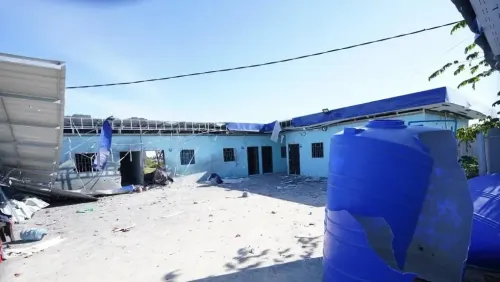What Did Australian PM Anthony Albanese Observe During His Tour of Flood-Affected Regions?

Synopsis
Key Takeaways
- Severe flooding has affected regions north of Sydney.
- Over 50,000 residents remain isolated due to floodwaters.
- Four confirmed fatalities have been reported.
- Experts warn about the dangers of entering floodwaters.
- Climate change may be impacting the frequency of such weather events.
Sydney, May 23 (NationPress) Australian Prime Minister Anthony Albanese and New South Wales (NSW) Premier Chris Minns visited areas north of Sydney on Friday that have been severely impacted by extensive flooding after five days of relentless rainfall. Four lives have been lost as bodies were recovered from the floodwaters, while a fifth individual has been unaccounted for since Wednesday. As of Friday afternoon, over 50,000 residents remain isolated due to flooding, with emergency services actively conducting rescue missions using boats and helicopters.
As of Friday, authorities had executed 736 flood rescue operations overall, according to reports from Xinhua news agency. The intense weather system responsible for the heavy rainfall moved south on Friday, and the Bureau of Meteorology (BoM) indicated that it could exit NSW by midnight.
Although conditions appear to be improving, officials have cautioned that river levels may still continue to climb.
Approximately 50,000 individuals in the NSW Mid North Coast and Hunter regions have been advised to prepare for evacuation, with experts highlighting that entering floodwaters is one of the gravest threats to safety.
“Four-wheel drives can create a misleading sense of safety when trying to navigate floodwaters, but studies indicate that 75 percent of all flood-related fatalities in the last 15 years have involved these vehicles,” stated Andrew Gissing, CEO of Natural Hazards Research Australia. He referenced research revealing that 84 percent of drivers ignore road closure signs, with young men under 29 constituting the majority of flood-related deaths.
Research following the catastrophic 2022 floods in northern NSW and southern Queensland indicated that nearly two-thirds of flood fatalities occur within 20 kilometers of people's homes, highlighting the risks residents face in familiar areas.
Friday marked the sixth consecutive day of intense rainfall in the Mid North Coast, resulting in record-breaking flooding and two fatalities.
Gissing observed that the Manning River at Taree in the Mid North Coast has surpassed its historic peak from the 1929 flood, reaching levels unseen in centuries. He urged the public to avoid floodwaters, cautioning that road surfaces can be quickly eroded, leading to life-threatening situations.
“You can never predict what lies beneath the surface. Floodwaters can easily wash away road surfaces, putting your life at risk as you could be swept off the road and into the current,” he warned.
While the effect of climate change on this specific event is still under evaluation, Gissing pointed out that rising temperatures enhance the atmosphere's ability to retain moisture, making heavy rainfall events more common.
He emphasized the necessity for increased investments in flood mitigation and risk-based urban planning to lessen vulnerability to future disasters.










